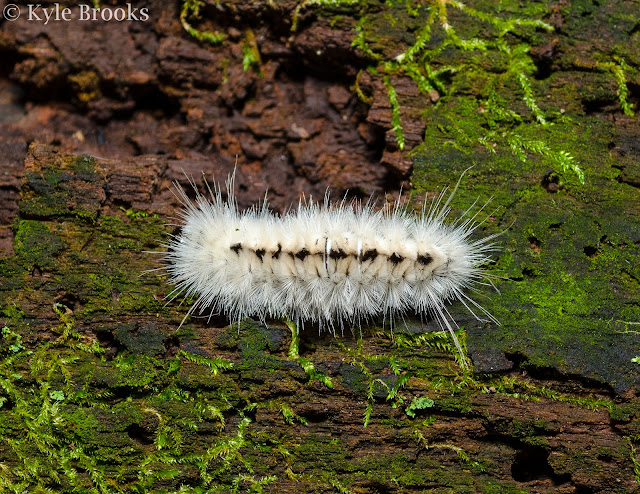Banded Tussock Moth caterpillars can come in a variety of color morphs. They can be gray, as you saw in the previous photo, but they can also be yellow, like the individual in the photo above. This is a very abundant species in the forests of the eastern US, and an observant hiker can often find several during a walk through the woods from July to October in a good year.
This fuzzy individual is a Salt Marsh Moth caterpillar, Estigmene acrea. Don't let the name full you; these guys are found all throughout North America (save Alaska and the Yukon), and not only in salt marshes. The caterpillars feed on a really wide variety of plants, and many times will be seen wandering around on the ground in search for new food sources.
While many caterpillars will feed on a variety of plant species, some specialize in only one or two specific groups of plants. An example of this would be the caterpillar of the Milkweed Tussock Moth, Euchaetes egle. This species feeds primarily on various milkweed species, but will also feed to a lesser extent on dogbane (Apocynum spp.). Like the Monarch, the Milkweed Tussock Moth has evolved an adaptation to withstand the toxins in milkweed plants (and also dogbane species), and they can consequently exploit a food source that many species cannot use. And, again like the Monarch, the Milkweed Tussock Moth is able to sequester a modified version of the toxin and use it as a personal defense. Although the Milkweed Tussock Moth and Monarch derive different toxic compounds (cardiac glycosides and cardenolide aglycones, respectively), the results are the same: a caterpillar or adult that is unpalatable to any would-be predators.
Next, I want to talk a bit about this infamous caterpillar. This is the Hickory Tussock Moth, Lophocampa caryae. It's infamy stems from the numerous news and social media stories passed around every year about its supposed "dangerous venom." But here's the thing: it is not venomous. This species is actually pretty harmless, but misinformed stories sadly continue to be shared via Facebook and even national news outlets. If you want to learn more, check out my post dedicated entirely to the Hickory Tussock Moth caterpillar, which you can read: right here!
What about the wive's tale which claims the amount of orange/red on the Woolly Bear indicates how harsh the winter will be? It's just that—a wive's tale. Even within a single batch of eggs, each caterpillar can vary in the ratio of black to orange. The central band also grows with age, and it has nothing to do with the weather.
 |
| An adult Woolly Bear, known as an Isabella Tiger Moth. |
The species covered in this post are only a fraction of the fuzzy caterpillars out there—there are dozens and dozens of other species. If you're really interested in identifying caterpillars of all kinds, I highly recommend the Princeton Field Guide to Caterpillars of North America. It is a wonderful guide to caterpillars if you live in the Eastern US!






My 7 year old son wanted to know more about the caterpillars in ohio.. We really enjoyed reading this page.. He knows now that the Woolly Bear is harmless compared to the white caterpillars we have in the yard.. Thanks..
ReplyDeleteThat's great to hear! There's a whole world of awesome caterpillars out there, and I hope your son continues to explore their world as he grows up!
DeleteI just found the salt marsh and now have a name for it thanks to your blog!! thank you for helping me identify this little friend!
ReplyDelete